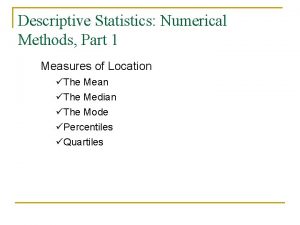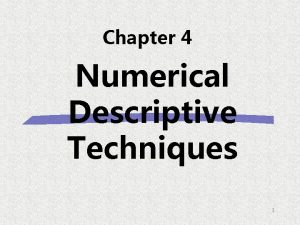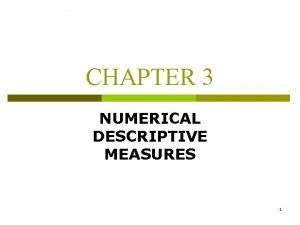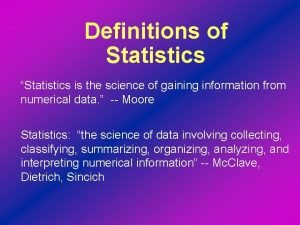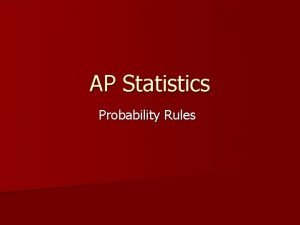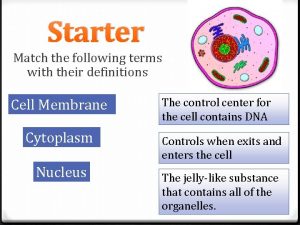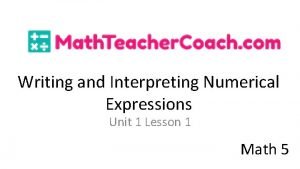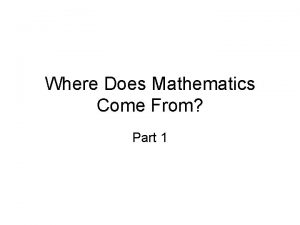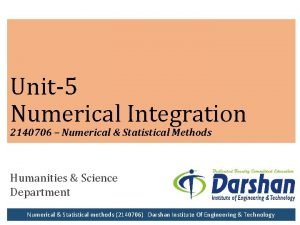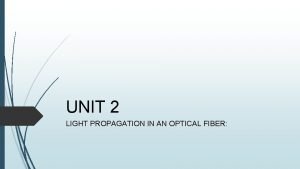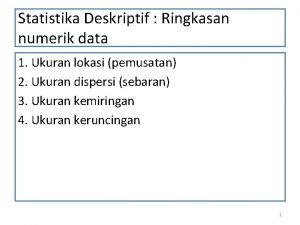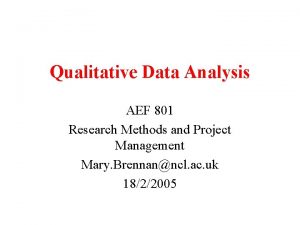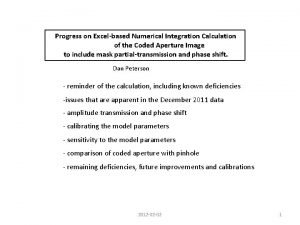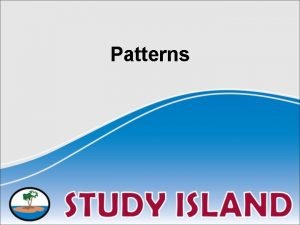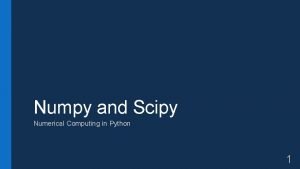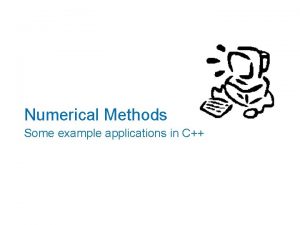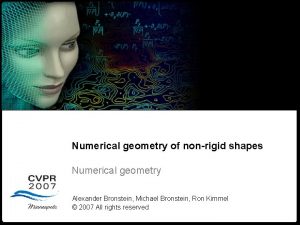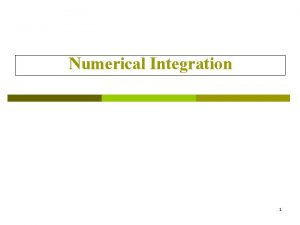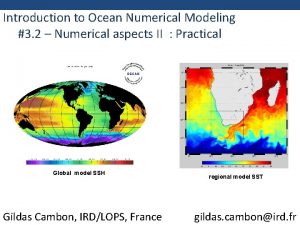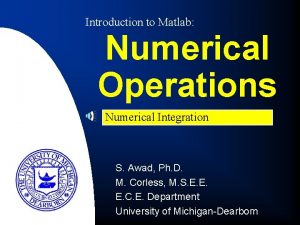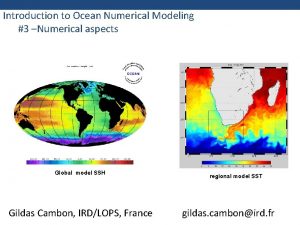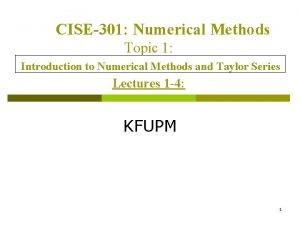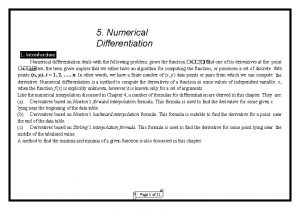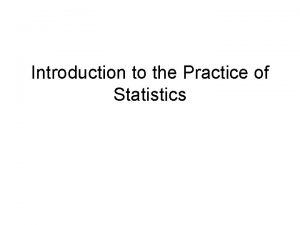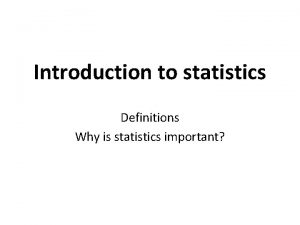INTRODUCTION TO STATISTICS Definitions Statistics is a numerical




















- Slides: 20

INTRODUCTION TO STATISTICS

Definitions • • “Statistics is a numerical statement of facts in any department of enquiry placed in relation to each other’. -Bowley “Statistics are the classified facts representing the conditions of the people in a State specially those facts which can be stated in numbers or any tabular or classified arrangement”. -Webster “Statistics can be defined as the aggregate of facts affected to a marked extent by multiplicity of causes, numerically expressed, enumerated or estimated according to a reasonable standard of accuracy, collected in in a systematic manner, for a pre-determined purpose and placed in relation to each other”. -Secrist Statistics is the science of collecting, organizing , analyzing, interpreting and presenting data.

SCOPE OF STATISTICS 1. Social Sciences -Man Power Planning -Crime Rates -Income & Wealth Analysis of Society -In studying Pricing, Production, Consumption, Investments & Profits etc. 2. Planning -Agriculture -Industry -Textiles -Education etc. For ex. Five Year Plans in India.

SCOPE OF STATISTICS contd… 3. Mathematics -Extensive use of Differentiation, Algebra, Trigonometry, Matrices etc in modern business analysis. -Statistics now treated as Applied Mathematics. 4. Economics - Family Budgeting -Applied in solving economic problems related to production, consumption, distribution of products as per income & wealth related patterns, wages, prices, profits & individual savings, investments, unemployment & poverty etc.

SCOPE OF STATISTICS contd… 5. Business Management - Trend Analysis - Market Research & Analysis - Product Life Cycle i) Marketing Policy Decisions depend on forecasting, demand analysis, time & motion studies, inventory control, investments & analysis of consumer data for production & sales.

SCOPE OF STATISTICS contd… ii) Production - Designs - Methods of Production - Technology Selection - Quality Control Mechanisms - Product Mix - Quantities - Time Schedules for Manufacturing & Distribution

SCOPE OF STATISTICS contd… iii) Finance -Correlation Analysis of profits & dividends, assets & liabilities -Analysis of income & expenditure -Financial forecasts, break-even analysis, investment & risk analysis iv) Sales -Demand Analysis -Sales Forecasts v) Personnel - Wage plans, Incentive plans, Cost of living, Labor turnover ratio, Employment trends, Accidental Rates, Performance Appraisals etc.

SCOPE OF STATISTICS contd… vi) Accounting & Auditing -Analysis of Income, Expenditure, Investment, Profits and Optimization of Production etc - Forecasting costs of production & price vii) Other Areas -Insurance, Astronomy, Social Sciences, Medical Sciences, Psychology, Education etc.

LIMITATIONS OF STATISTICS Does not study individual items, deals with aggregates. Statistical laws are not exact. Not suitable for the study of qualitative phenomenon. Statistical methods are only means and not end for solving problems.

Definitions Continued Observations: Numerical quantities that measure specific characteristics. Examples include height, weight, gross sales, net profit, etc.

Some More Definitions • Raw Data: Data collected in original form. • Classes / class intervals: Subgroups within a set of collected data. Ex. 10 -20, 20 -30 etc • Width of class-interval = upper limit – lower limit Mid – Value = (U. L + L. L)/2 • Frequency: The number of times a certain value or class of values occurs. • Frequency Distribution Table: The organization of raw data into table form using classes and frequencies.

More Definitions Cumulative Frequency of a class is the sum of the frequency of that class and the frequencies of all the preceding or succeeding classes which are listed in some sensible order (numerical order, alphabetical order, etc. )

Illustration – Individual Series Marks of ten students of a class in Statistics 15, 35, 55, 67, 78, 84, 79, 90, 89, 94

Illustration – Discrete Frequency Distribution Height (in inches) No. of Students 60 12 62 18 64 10 66 6 68 4

Illustration Grouped or Continuous Frequency Distribution Exclusive Type Class – Intervals Class. Intervals Frequency 20 -25 8 25 -30 2 30 -35 40 35 -40 23 40 -45 9

Illustration – Grouped or Continuous Frequency Distribution contd… Inclusive Type Class - Intervals Class. Intervals Frequency 1 -10 2 11 -20 6 21 -30 10 31 -40 15 41 -50 12

CONVERSION OF INCLUSIVE TYPE CLASSINTERVALS TO EXCLUSIVE TYPE CLASS INTERVALS Calculate ADJUSTMENT FACTOR as follows: A. F= Lower Limit of Next C. I – Upper Limit of Previous C. I 2 using the given inclusive type class intervals. 2. Obtain new class intervals as follows: New Lower Limit = Old Lower limit – A. F New Upper Limit = Old Upper Limit + A. F

CONVERSION OF INCLUSIVE TYPE CLASSINTERVALS TO EXCLUSIVE TYPE CLASS INTERVALS contd… Class. Intervals 1 -10 Frequency A. F = (11 – 10)/2 = 0. 5 2 For 1 st C. I i. e 1 -10 New L. L = 1(old L. L) – 0. 5 11 -20 = 0. 5 6 New U. L=10(old U. L) +0. 5 21 -30 10 31 -40 15 41 -50 12 = 10. 5 And so on.

CONVERSION OF INCLUSIVE TYPE CLASSINTERVALS TO EXCLUSIVE TYPE CLASS INTERVALS contd… Class. Intervals Frequency 0. 5 -10. 5 2 10. 5 -20. 5 6 20. 5 -30. 5 10 30. 5 -40. 5 15 40. 5 -50. 5 12 Now calculations can be made.

Obtaining Cumulative Frequency Distribution Class -Intervals Frequency Less than type cum frequency More than type cum frequency 20 -25 15 15 60+15=75 25 -30 34 15 +34 =49 26 + 34 = 60 30 -35 6 49 + 6 =55 20 + 6 = 26 35 -40 10 55 + 10 = 65 10 + 10 = 20 40 -45 8 65 + 8 = 73 2 + 8 = 10 45 -50 2 73 + 2 = 75 2
 Numerical descriptive statistics
Numerical descriptive statistics Numerical methods of descriptive statistics
Numerical methods of descriptive statistics Jack in the
Jack in the Standard deviation formula for ungrouped data
Standard deviation formula for ungrouped data Introduction to statistics what is statistics
Introduction to statistics what is statistics Definitions for statistics
Definitions for statistics Ap statistics definitions
Ap statistics definitions C programming lectures
C programming lectures Match the following terms and definitions
Match the following terms and definitions What is a numerical expression
What is a numerical expression Numerical stroop
Numerical stroop Simpson 1/3 rule
Simpson 1/3 rule Angle of acceptance cone is twice the
Angle of acceptance cone is twice the Ringkasan numerik
Ringkasan numerik Counterdiscipline
Counterdiscipline Excel numerical integration
Excel numerical integration Basic algebra definition
Basic algebra definition Numerical patterns
Numerical patterns Graphical and numerical methods
Graphical and numerical methods Numerical computing with python
Numerical computing with python Setprecision in c++
Setprecision in c++
